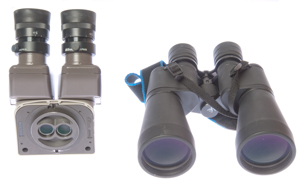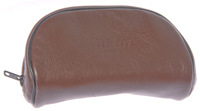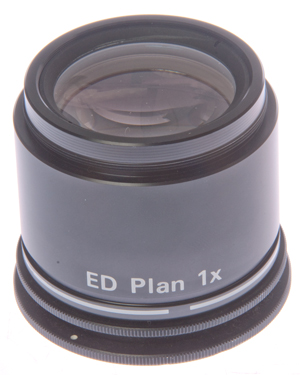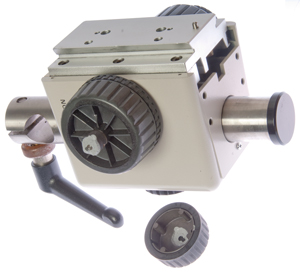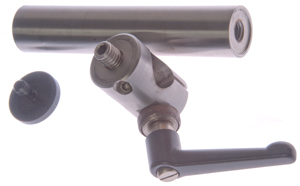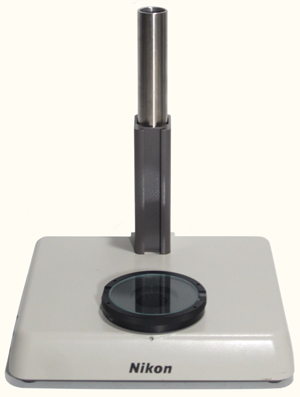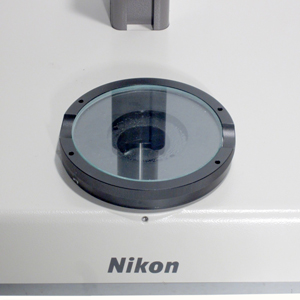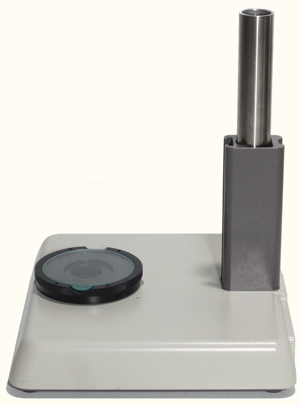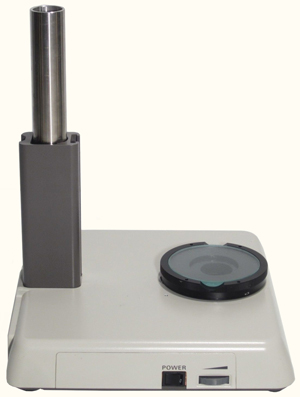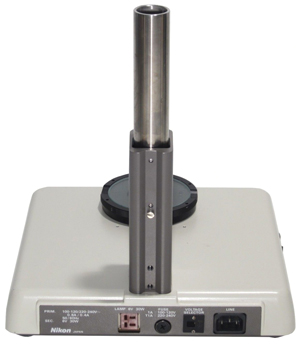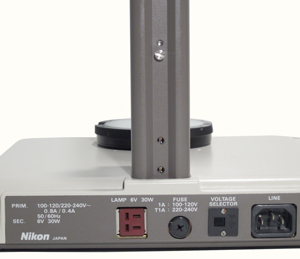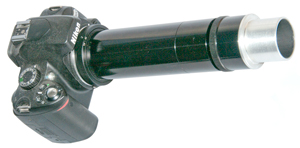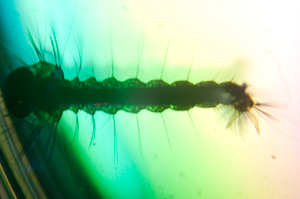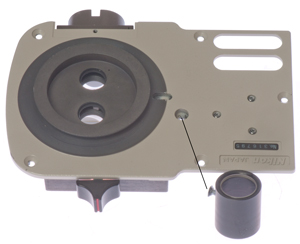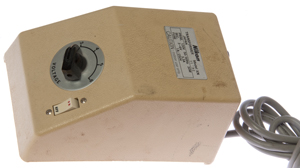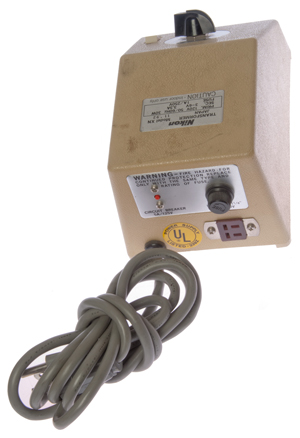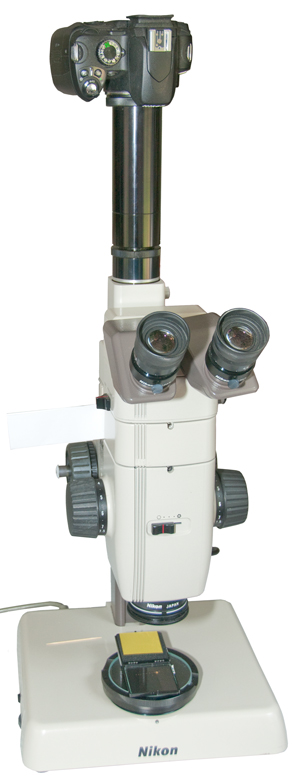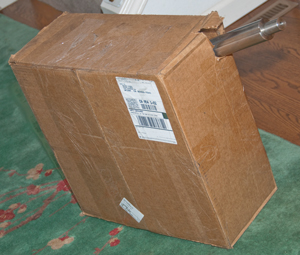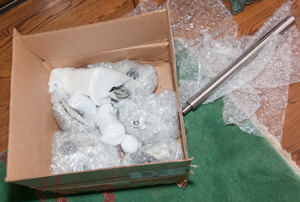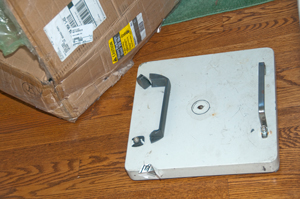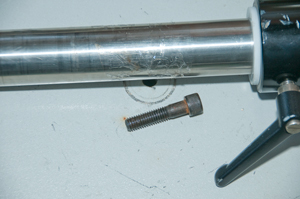Nikon SMZ-U Stereo Zoom Microscope
© Brooke Clarke 2015 - 2024 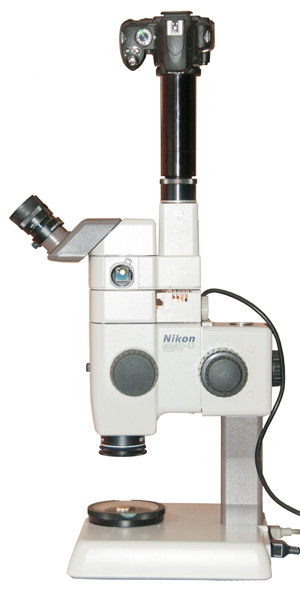 |
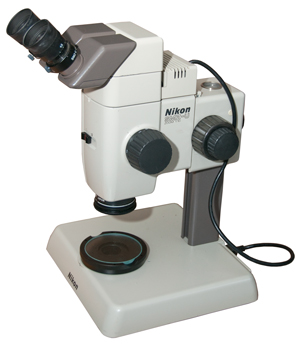 |
Description
Infinity Tube Head D
Infinity Tube Head L
Eyepieces
Main Zoom Body
Objective
Focusing Mount
Arm Stand
Plain Stand
Diascopic Stand
Beam splitter Camera ISO Port - optional Side Port
Modification for Infinity Camera
Camera Port Background
Benefits of Infinity Focus Camera Port
Modification of Nikon SMZ-U Beam Splitter ISO Camera Port
Coaxial Epsioptic Illuminator
Bad Packaging
Patents
Related
Links
Background
I've been using a conventional compound microscope to look at the life in pond water and ended up shopping for lower power objectives. Then saw some fantastic photos of pond life taken with a stereo microscope so looked for a Nikon stereo microscope that was reasonably priced and the SMZ-U is one generation back from current. The current SMZ-1500 has a zoom range of 15 but wheres the SMZ-U is 10. For comparison the Bausch & Lomb StereoZoom 4 has a range of 4.3. The other problem with the B&L is that is does not have a trinocular head and this scope came with that accessory as well as an illuminator that works co-axially with the optics.
Description
Infinity Tube Head (Tube) "D"
The first part of the microscope I looked at was the binocular head. After installing the eyepieces I took it outside a looked at the mountain. After adjusting each eyepiece for focus the view is breathtaking!. These are the best binoculars I've ever looked through. Bright and with a wide field of view, I can see things that I haven't seen before. The lenses in the bottom of the head are about 16mm, so a binocular spec would b be 16x(power) so only a daytime binocular, but none the less an excellent one. When a flashlight is shined into the objective lens and a 3x5 card is moved back and forth to bring the spot of light into focus, the diameter of that spot is about 2.5 mm, so the power is about 6.5x (16/2.5).
16x6.5 binocular head. The eyepieces are marked 10x so I don't understand why the error in magnification.
Note the stereo view is right way around unlike the Eclipse series infinity binocular head that's upside down and backwards. This may be related to the difference between binocular and stereo. In stereo scopes the view is right way around making it easy to manipulate things.
Fig 2 Head (6.5x16 binoculars) compared to 9x56 binoculars
Note Nikon makes a 6x15M CF and 7x15M CF binoculars'
that have won design awards.
Fig 15
See: Binoculars\Nikon
Fig 2 Eyepiece end, central focus, diopter adj
Fig 3 exit pupil 2.5 mm
The dovetail is 59.5mm diameter. But unlike other Nikon microscopes the head can not be rotated because there's a locating pin. A 2mm hex wrench is needed to attach the head to the body.
Infinity Tube Head (Tube) "L"
The "D" head above has two movable parts that look like boxes, but the "L" head has two movable parts that look like arms with fists at the end.
Eyepieces
Marked: SMZ-U UW10xA/24
The barrel diameter is 29.9mm (commonly called 30mm). The "/24" marking is the reticle size. One of the eyepieces does have a reticle that I'm guessing is for framing a photograph.
They also have a pinch screw that instead of just impinging on the microscope instead push on a ring that's part of the eyepiece so that there's no marring of the microscope tube.
The reticle can be aligned by rotating the eyepiece and then clamped in the desired position with the pinch screw.
When there's no reticle the procedure to set the diopter adjustment is to first set the magnification to 7.5x (full open iris) and focus on a subject. Then back off the power to 0.75x and focus by using the diopter adjustments.
I think that when you focus on a reticle that eyepiece will be properly focused at all powers, but without a reticle the above procedure is needed.
Main Zoom Body
The zoom knobs on each side are marked from 0.75 to 7.5 power which is correct when a 1.0X objective is used.
The slider on the front is a diaphragm that works the same was as they do on a camera. Full open is the brightest images with the shallowest depth of field, and as it's stopped down the image gets dimmer and the depth of field increases.
Fig 3 SMZ-U head
Fig 4 SMZ-U head
Objective
The objectives have a 55mm male thread.
In addition to the stock 1.0x objective here are optional objectives with powers of 0.5x, 0.75x, 1.5x and 2x.
ED refers to Extremely low Dispersion which relates to the use of fluorite glass in the optical design. Because of the
low dispersion (Wiki) optical systems have lower Chromatic aberration (Wiki). The Nikon "ED" may use the fluorite element behind a glass element so that the fluorite element is protected from damage.
The 1/4 wave plate is part of the Coaxial Episcopic Illuminator (see below) and allows cancelling specular reflections just like is done with a polarizing filter on a camera.
Fig 5 1X Objective
marked: ED Plan 1X
White dot is on 1/4 wave plate which can be turned
using bottom knurled ring.
55mm threads at top attach to scope body.
Focusing Mount
This is a separate from the stand and will work with any of the stands. It's sole function is to move the scope up/down for focus. It may have been designed this way since stereo microscopes are often added to commercial products, like wire bonders, where some providion needs to be made for focus but none of the standard stands are used.
The knob was broken off because of bad packaging.
Shaft is part of the Arm stand. A different shaft is used with the plain stand.
Fig 13
Fig 14
Arm Stand
The base weighs about 70 pounds. The arm that holds the focusing mount is in two pieces that can be unscrewed. Maybe to allow for different lengths?
The black clamping levers are spring loaded so when pulled out the level can be positioned so it's out of the way of the other levers.
When the levers clamp down they are clamping against thrust bearings rather than clamping against the friction of the clamp body.
The vertical post is just under 44mm O.D.
The horizontal are is just under 44mm O.D and has a groove so it will not rotate.
At the end of the horizontal are it's diameter is reduced to 25mm where the end clamp acts.
There's an adjustable friction adjustment on that 25mm diameter
The short arm is just under 32mm O.D., the same O.D. and the plain stand vertical column.
Any one have thoughts on adding a camera bracket to hold the Nikon D300s?
This arm stand was NOT made by Old School Industries (OSI). It's a Chinese copy. Still looking for a 1/4-20 camera adapter.
Machinery 25 x 5mm Thread Metal Adjustable Handle (but I don't see any that have 3/8-16 threads, they all seem to be metric sizes).
Plain Stand D
It may be that although the stand contains an adjustable 2 to 6 VAC power supply that it does not contain a source of light. That's to say that it can only be used to power an external light like the Coaxial Episcopic Illuminator (see below)
The "Clamp Screw" is a tool that's a 2mm hex bit with a disk on one end. It's stored at the top of the pillar.
The stock pillar height is OK for objectives of greater or equal to 0.75 power, but for the 0.5X objective the optional longer pillar rod is required.
There is a Nikon "stage adapter". It's a hollow cylinder with a flange on the bottom with some screws that attach to the base of the plain stand D. At the top is a 46mm diameter bevel that will accept the Nikon Labophot X-Y stage. This stage can be rotated, but does not have any degree scale for rotation, like would be used for polarization studies.
The top of the support metal post is 31.9mm diameter, just under 32mm O.D. same as the short arm on the Arm Stand above.
eBay Photos
Described as having a Floating Specimen Stage- The black metal ring with the glass plate can be moved about. I has thick grease to keep it from moving on it's own.
The clamping ring is missing, but for the existing setup the SMZ-U just sits directly on top of the outer column so there's no room for the clamping ring.
eBay Fig 1
eBay Fig 2
eBay Fig 3
eBay Fig 4
eBay Fig 5
eBay Fig 6
Fig 40 Plain Stand D with SMZ-U focusing mechanism
Fig 41 Broken fine focus knob
missing 2mm hex wrench column cap.
Diascopic Stand
This stand has very sophisticated illumination and may also be called the light field - dark field stand.
Beam splitter Camera ISO Port - optional Side Port
This beam splitter ISO camera port is an add on accessory instead of a completely new head. The left side optics feed the ISO port with 100% of the light or by using the sliding switch choose to split the light between the left eyepiece and the camera port.
On the right side there's a hold for an optional Side Port which allows adding a second camera. It would be interesting to see if Sony have made public the details on how to make stereo images that are compatible with their Bravia series 3D HD TV sets. So for now the camera port is limited to 2D video and/or still photography.
See: Labophot ISO Camera Port
Beam Splitter photos
Because of Bad Packaging the slide selector for Bino or Camera+Bino is very hard to move.
Fig 6
Fig 7
Fig 8
Opening SMZ-U Camera Port
Loosen the 2mm hex screw holding the plug in the optional side port and remove the plug.
screw in the 2mm hex screw so it sill clear the "U" metal cover.
Remove 3 each small (+) screws and remove the "U" metal cover from the side port area.
Remove 5 each medium (+) screws from the bottom plate and remove the bottom plate with all the optics.
The first thing that can be seen is the 45 degree mirror is very dirty, probably because dust falls down the open ISO camera tube.
When the switch is in the Bino position the prisms are retracted and not under the top holes and so remained clean.
Placing a very small drop of Nye clock oil on each side of the brism block and sliding back and forth solved the problem.
It's now working just fine.
Lesson: Keep microscope under a dust cover when not in use.
Notice that then the slider is in the Photo+Bino position in Figs 20 & 21 below the lower prism sends light to the 45 degree mirror and up to the regular ISO camera port. The bottom prism sends the light out the side port and is closer to the microscope and so might work better for direct projection onto the camera's imaging chip and in a way that would be parafocal with the eyepieces.
The side port is a little over 1" I.D. and so is NOT an ISO camera port, but instead a proprietary Nikon port only good for their ISO camera adapter option or a custom option.
Fig 20
Fig 21 Cylindrical tube is for focusing a tube lens.
On SMZ-U microscope
Since I did not see any lenses inside the photo head I expected
an infinity type image in both photo ports. When looking into
the non ISO side photo port I see an image at infinity with my eye and when hand holding the camera with 200 mm infinity tube setup
to the port get a good image.
But when the infinity tube setup is installed on the top port the
image is very fuzzy.
Hand holding just the camera head and shining a laser into each of the bottom entrance holes you get a normal laser dot and a much larger fuzzy area in the top camera port indicating there's a lens.
When the ISO adapter from the Labophot it takes a lot of refocusing, but you do get an image.
So the lens in the cylindrical barrel is there to make this ISO port look like the ISO port on a 160mm tube length microscope so the same photographic relay lenses can be used.
I think a cleaner and better solution would have been to keep the infinity optics and use an external 200mm tube lens like in the photo at right.
OI can still do this be making an adapter for the side port which has no lenses. That adapter could be either side port to T2 or side port to ISO. It doesn't make much difference because with infinity optics distance differences don't matter. But hanging a Nikon D300s off the side with either of these adapters will probably cause the microscope to fall over sideways. So an adapter like the optional side port unit makes sense. But does it have a lens?
Micro Photography Nikon D60 with Infinity Tube & ISO adapter
A doublet lens with 200mm focal length is in the adjustable
section of the T2-mount with a T2-ISO adapter (raw aluminum) on the end.
This amounts to a 200mm lens that's focused at infinity. aka an astronomical telescope.
Mosquito larva from pond
Using Coaxial Episcopic Illuminator hand holding on side port.
Mosquito larva from pond photo of 30mm dia petri dish with 105mm close up lens
These are too big for microscope viewing when alive and moving.
Modification for Infinity Camera
Camera Port Background
The old design compound microscopes used 160mm tube length (there were other tube lengths, but this is by far the most common fixed tube length) and standardized dimensions for eyepieces and objectives so that they could be interchanged. When Triocular microscope heads first came out they just added a third eyepiece tube and a family of photographic eyepieces (aka: relay lens). The photographic eyepiece set the scale factor of the camera image and there was some other provision to focus the camera port.
Once setup the combined microscope and camera were typically not separated. In some cases it would be possible that the focus adjustment would be correct for both the camera and the eyepieces at the same time, but not always. When working with used microscopes and digital cameras when the original system used a film camera there are many things that seem to be less than optimal.
I was able to take the ISO port relay lens and set of adapters off the Labophot microscope and install them on this SMZ-U microscope, but in order to get focus I needed to make a large change in the stage height. That means the eyepieces and the camera have very different focus points. This is a big hassle. It's really desirable so have the focus for the eyepieces the same as for the camera. This could be done on the Labophot by making custom machined eyepiece extenders. I"m not sure what it would take to get the SMZ-U parfocal (Wiki) with the existing design, but I've got a better idea. Remove the tube lens in the head making the ISO port at infinity focus!
Benefits of Infinity Focus Camera Port
The head (eyepiece tube) on this microscope and most new "infinity" design microscope are essentially astronomical telescopes or astronomical binoculars. What that means is that if you use them to look at a distant object you will see a real image at infinity focus. If the camera has a "tube lens" attached to it and focused then no further focusing is needed. You just install the infinity camera and take photos.
The infinity tube lens for the camera has a locked focus.
No more focus hassle and easy conversion back to normal camera operation, i.e. camera does not need to be dedicated to the microscope.
Modification of Nikon SMZ-U Beam Splitter ISO Camera Port
All that's needed is to remove the existing tube lens from the head. First remove the cover, see Opening SMZ-U Camera Port above. Remove the No. 2 Philips screw and the tube lens cylinder. Reassemble the head.
Note: I expect that optional Side Port contains both a 45 degree mirror and a tube lens so would need to be modified also.
Coaxial Episcopic Illuminator
Episcopic is the Nikon term for illumination from above or more accurately light fed along the same path used for viewing only in the other direction, like is used for metallurgical illumination. Discopic is their term for light from below.
Although this transformer uses the same connector as the Nikon UN transformer the sockets are wired differently so they can not be interchanged. Maybe because this XN transformer is for a 6 Volt lamp and the UN transformer is for a 12 Volt Lamp.
Note the transformer is not needed when the Plain Stand D is used.
Fig 37 below shows blocking the left light path with a 3x5 card.
Fig 37 Blocking one of the light paths with folded 3x5 card
Metelics B42 Beam Lead Ring Quad with one light path blocked
Bad Packaging
The horizontal support bar came out of the package onto the UPS driver's foot. It was not anchored inside the box, an example of poor packaging. The loose bar broke one of the knobs on the focusing mount even though the focusing mount was wrapped in bubble wrap.
Focusing Mount has a knob broken off and the ISO Port beam splitter slide is very hard to move.
There is another box still due, so the total extend of the bad packaging is yet to be determined.
Patents
3507555Zoom lens optical system, Nippon Kogaku Kk, Apr 21, 1970, 359/686 - 10 to 1 zoom range
3609005Varifocal optical system for zoom lens having ultra-high zoom ratio, Nippon Kogaku Kk, Sep 28, 1971, 359/687, 359/690 - greater than 20 to 1 zoom range
5838492Method and apparatus for a binocular optical system, Nikon Corporation, Nov 17, 1998, 359/426, 359/383, 709/236, 359/407 - looking at model in stereo
6320702Afocal zoom lens, and microscope having the lens, Nikon Corporation, Nov 20, 2001, 359/686, 359/380, 359/376, 359/744, 359/660 - greater than 14 to 1 zoom range
7245425Microscope optical system and microscope objective lens , Nikon Corporation, Jul 17, 2007, 359/384, 359/381, 359/380 - Common Main Objective & Infinity optical system
Related
Microscope Objective Standards
Table of Microscope Objectives & photos taken with camera (not microscope)
B&L Stereo Zoom Microscope
Unitron No. 83444 Microscope
Mitutoyo Toolmakers Measuring Microscope 176-134
Nikon Labophot Microscope & accessories
Nikon Multiphot stand & Table of Nikon "phot" microscopes
DigitalPhotography101 Digital Photography 101: The Basics
Digital Photography 201 Stacking Images
Digital Photography 202: Close-Up, Macro & Micro
Digital Photography 203: Color Management
Digital Photography 204: Studio Flash
Digital Photography 205: Astrophotography
Digital Photography 206 Micro Photography - Tube Lens - Unitron Compound Microscope
EOG Electro-optical Gadgets
Hilger Watts Spectrometer - Foldscope, , Leeuwenhoek Replica, Bullet
Lights sources
Mitutoyo Toolmakers Measuring Microscope 176-134
Nikon Nikon (and Kodak DC290) Cameras
Nikon Labophot Microscope (compound microscope - eyepiece & objective lenses)
Nikon Multiphot System - Macro photography stand and list of "phot" family microscopes
NikonSB25 - Nikon SB-25 Flash & Manfrotto C1575B Avenger Super Clamp
Omnicon 3800 Tumor Colony Analyzer (TCA) Automated Inverted Biological Microscope (came with Nikon objective)
Optical Bench w/ old Microscope
Optical Spectrum Analyzers
Optics Day & Night
Simple Microscopes (single lens) -
Spectronic 20D Spectrophotometer
Links
PRC68, Alphanumeric Index of Web pages, Contact, Products for Sale
Page created: 23 Feb 2015
